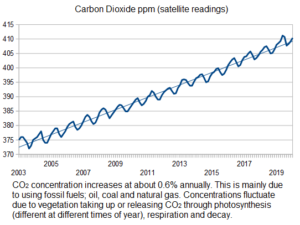The basic principle of life is balance. Balance can be dynamic, more at some times and less at other times, but the system must balance to be sustainable. All living creatures interact with the environment around them. A reliable climate is needed to enable the creatures to balance their inputs and outputs, which is what is needed to thrive.
The climate system
- Atmosphere (air)
- Hydrosphere (water)
- Cryosphere (ice and permafrost)
- Lithosphere (earth’s upper rocky layer)
- Biosphere (living things)
Circulation – energy and nutrients
Internal-to-system variations e.g. North Atlantic Oscillation, volcanoes
External-to-system variations e.g. earth orbit, which causes seasons
Previous periods of climate change
Causes of climate change
- Greenhouse gases
CO2, Methane, Other;
- Fossil fuel burning (coal, oil, gas and wood) for energy consumption; agriculture, deforestation, and manufacturing.
Effects of climate change
- Weather patterns, violent storms, flooding, destabilisation of hydrological cycle.
- Temperature rise modified by climate feedbacks: snow and ice reflect sunlight, warmer temperatures increase evaporation and more intense weather.
- Increases amount of water vapour (which is also a greenhouse gas), changes to land and ocean carbon sinks.
- Land warming, leading to desertification, heat-waves, wildfires.
- Rising sea levels.
- Sea warming, leading to effects on marine life, ocean acidification.
Impacts on ecosystems: species relocation, extinctions.
Impacts on humanity
- Decreasing habitability of tropical and arid regions so climate refugees
- Rising sea levels
- Food and water scarcity, flooding, infectious diseases, extreme heat, economic losses.
Climate Science
- Evidence that the majority of the rapid warming of our planet over the past century has been forced by increasing greenhouse gas concentrations.
- Climate modelling; data showing warming and analysis of patterns.
- Current situation + 1.2 °C, human population: increase and effects.
- Projected situation: the Intergovernmental Panel on Climate Change (IPCC) series of reports; tipping points; human population.
Addressing climate change
- Reducing carbon emissions by using renewable energy: Solar, wind, water, geothermal
- Removing Carbon at its industrial source
- Adaption: crop substitution, building seawalls, planning water supply
- Geoengineering:
a) Sucking CO2 out of the atmosphere (plants, chemicals that react with CO2)
b) solar radiation modification (stratospheric aerosol injection (modest amounts of sulphur form of sulphate aerosols that reflect sunlight. Fairly cheap), reduce trapping of heat, changing albedo of arctic ice, space based mirrors)
- Legacy carbon
- Reforestation and biodiversity
- 2015 Paris Agreement
Data Source: https://climate.copernicus.eu/